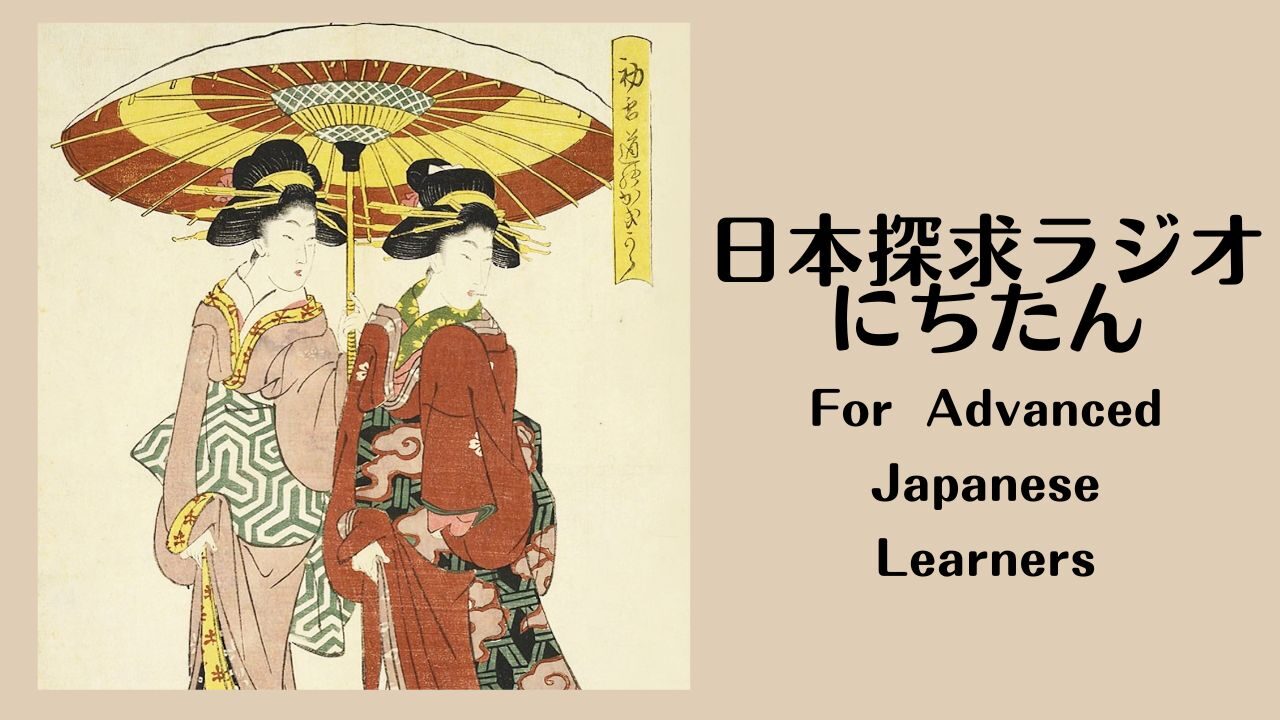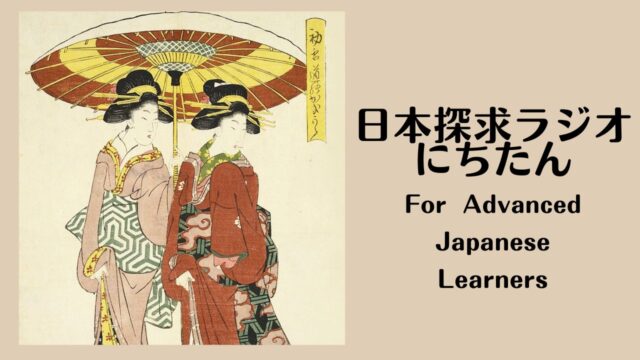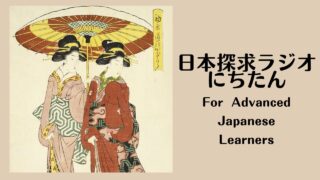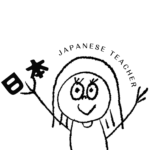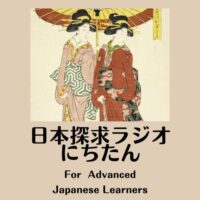下記のポッドキャストエピソードの概要ページです。
This is a summary for the following podcast episodes.
左上右下(さじょううげ)|Left over Right

まず日本にはどうして「左上右下」の文化があるのか。日本が飛鳥時代(593年-710年)のころ遣唐使などを通じて中国(当時は唐)から伝わったと言われています。
It is said this ritual has been introduced to Japan from China around 600s.
唐では皇帝が不動(動かない)の北極星を背に南に向かって座るのがよしとされ、太陽が東から上り西へ沈むことから東、つまり左が偉いとされました。
In the Tang Dynasty, it was considered good for the emperor to sit facing south with his back to the immovable North Star, and since the sun rises in the east and sets in the west, the east(=left) was considered to be the most important.
中国は歴史の中で何度も左右の上下が変わりましたが、日本ではそのまま左が上のルールが根付きました。
In China, the idea which is more important has changed many times throughout history, but in Japan we continued to use “Left over Right”.
ではこれから色んな「左上右下」を紹介します。全て当事者=本人から見た左右を考えてください。
I’m going to introduce you to various 「左上右下」. Please think of left or right from the viewpoint of someone at the scene.
舞台|Stage

舞台での左右の言い方について。演者、立つ人から見て左が上手(かみて)、右を下手(しもて)と言います。
The left side of the stage is called “kamite” and the right side is called “shimote” from the perspective of the performer.
「上」「下」が使われていて、「左上右下(さじょううげ)」の考えが表れています。
The use of “up” and “down” expresses the idea of “Left over Right.”
日本では政治の記者会見のときに左=上手から出てきます。対してホワイトハウスでは右(=アメリカでの上手)から出てきます。
In Japan, Prime Minister comes out from the left (=upper side) at a press conference. In contrast, in the White House, they come out from the right side (=upper side).
右から出てくるジェン・サキ報道官
入口の場所が上から出てくる構造になっています。ここにも左右の上下の考えの違いがでているのではと思いました。
The entrance location is structured to come out from the top. It is interesting.
米|Rice
ご飯やお味噌汁などを並べるとき、一番手前の左はご飯です。どうしてご飯をここに置くのか?色んな説があるのですが、その一つが「左上右下」の考え方です。
Rice is on the left in the very front. Why? There are many theories, and one of them is from the idea based on “Left over Right”.
古来の日本では白米は神様へのお供えなど神聖なもの、また年貢=昔の税金に米が使われ大切なものとされてきました。よってご飯が一番偉く、左に置くとされています。
Long time ago rice was considered sacred as an offering to God, and was used to pay tax. Therefore rice was considered important and should be placed on the left.
着物|Kimono

着物の上は着ている本人からみて左です。左が上、つまりここにも「左上右下」の考えが表れています。
We wear Kimono with the right side over the left which is based on the idea of “Left over Right”.
着付けの用語ではこれを「右前」と言います。ここでの「前」は時間的に前=「先」という意味合いです。
In kimono terminology, this is called 「右前(Migi mae)」 . Mae means “first” here.
右を先に着つけて左を重ねるので右が先=「右前」。つまり左が上にくるということです。
Since the right side is worn first and the left side is piled up, the right side comes first =「右前(Migi mae)」 which is the left side comes on the top.
「左上右下」の着物。逆に「左前」=右が上の場合はお葬式で故人(亡くなった人)が身につける死者を葬る白い着物を着るときです。経帷子(きょうかたびら)、死装束などと呼ばれます。
On the other hand, wearing a Kimono with the right side over the left is how dead people wear it. It is called 「左前(ひだりまえ)」.
仏教では今生きている世界と死後の世界は真逆になっているという考え方があり、その影響から主に葬儀に関するものごとでは逆さ事(逆にする)という風習がいくつもあります。
In Buddhism, there is a belief that the world in which we live and the world after death are the opposite. Because of this belief there are some customs that are mainly related to funeral rites that are done upside down.
アニメなどでもお化けや幽霊の着物は通常とは逆の「左前」になっています。
You can see ghost wearing Kimono with「左前(ひだりまえ)」 on Japanese anime.
👻🎵音楽情報🎵👻
— 「社畜さんは幼女幽霊に癒されたい。」公式アカウント (@shachisaretai) May 19, 2022
6月15日(水)発売のTVアニメ「社畜さんは幼女幽霊に癒されたい。」オリジナル・サウンドトラックのジャケットが公開となりました!!✨
劇中のほっこりする音楽を聴いてぜひ癒されちゃってください…☺🍵
詳細は⏩https://t.co/7xXtwyNw1b#しゃちされたい pic.twitter.com/868AZStYzQ
国会議事堂|National Diet Building

国会議事堂にも「左右上下」の考えが表れていると言われています。
It is said that the idea of “Left over Right” is also expressed in the National Diet Building.
日本の国会は衆議院と参議院の二院制です。
Japan’s National Diet is composed of two parallel houses, the House of Councillors(衆議院) and the House of Representative(参議院).
国会議事堂の建物はほぼ左右対称のシンメトリー(symmetry)で、左つまり上にあるのは参議院です。
The National Diet building is symmetrical and the left side is 参議院(さんぎいん) and the right side is 衆議院 (しゅうぎいん).
なぜ参議院のほうが上かというと参議院は元は貴族院だからです。
That is because 参議院(さんぎいん) was formerly 貴族院(きぞくいん) .
貴族院は皇族議員や華族議員などによって構成されていました。日本には1947年まで「華族」という貴族がいました。華族は他の人々より上の立場です。その華族などが貴族院を構成していたので国会議事堂の左つまり上の位置づけにあるのは貴族院・今の参議院です。
貴族院(きぞくいん) was composed of members of the Imperial Family and members of the noble families. In Japan, there was 華族(かぞく) which is the noble class until 1947. 華族(かぞく) was above all other people. 華族(かぞく) constituted 貴族院(きぞくいん), so 貴族院(きぞくいん) now the House of Councilors, is located to the left of the National Diet building.
帝国議会=昔の議会の開会式は天皇のお席=玉座(ぎょくざ)がある貴族院で行われていました。現在の国会開会式が参議院で行われるのはその名残です。
The Emperor’s seat is located at the top of the stairs in 参議院議場. This is a remnant of the fact that貴族院(きぞくいん) was higher than the House of Councilors.
The opening ceremony of the Imperial Diet welcomed the Emperor to 貴族院議場.
天皇は玉座(ぎょくざ)で開会のおことばを述べられます。衆議院・参議院両院の希望者が参加し、天皇のお言葉を聞くために議場内に集まります。
Still now the Emperor comes to 参議院議場 for the opening ceremony and he delivers his opening speech. And member of parliament (both 衆議院 and 参議院) comes to 参議院議場 to hear it.
アニメ|Anime
これはネット情報ですが、アニメにも「左上右下」の影響があると言われています。
This is internet information, but it is said that there is also an “Left over right” influence in Japanese anime.
上の者つまり強い人は左から現れる。視聴者(アニメを見る人)から見て右側です。
The strong one appears from the left.
逆に右から出てくる者は下の者、弱者というわけです。視聴者から見て左側です。
Conversely, the weak one appears from the right.
この原則に従ってアニメは作られ、視聴者は説明がなくとも二者の暗黙の関係性、上下関係を理解するのだとか。
Japanese animations are created according to this principle, and viewers understand implicitly the hierarchical relationship without explanation.
アニメ序盤では強い人はだいたい敵役で、主人公は弱い立場であることが多いです。よって戦闘シーン(戦う場面)では敵役が左、主人公が右から出てきます。
In the early stages of anime, the strong person is usually the enemy, and the main character is often in a weak position. Therefore, in battle scenes the enemy comes out from the left and the main character comes out from the right.
そして物語が進むにつれて主人公・ヒーロー(hero)が、左側から登場するようになり敵、悪者をやっつける。登場する側が変わっていくことで主人公の成長、強くなっていくことが描かれていきます。
As the story progresses, the hero appears from the left side and defeats the enemy. It depicts hero’s growth and strength using “Left over Right” .

単語|Words
- 唐(とう)…Tang Dynasty of China(618-907)
- 皇帝…emperor
- 不動(ふどう)の北極星(ほっきょくせい)…immovable North Star
- 上手(かみて)…Stage Left
- 下手(しもて)…Stage Right
- 神聖(しんせい)…sacred
- 年貢(ねんぐ)…昔の税金、tax in old ages
注意事項|Causion
このポッドキャスト(Podcast)は私が調べたことをお話しています。
役に立つ正しい情報をお伝えしたいと思っていますが、事柄によっては色んな説があるものや歴史など古い出来事で通説(恐らくこうだろうという考え)に基づく話もあります。
また正しい情報をお伝えできるようきちんと調べているつもりですが、私が勘違いして間違えていることもあるかもしれません。
ですのであくまである個人が情報を調べてお話しているということをご理解の上、聞いてくださると幸いです。
特にネット情報だと紹介したところはご注意願います。
気になることや興味があることはご自身でもぜひ調べて確認してみてください。
どうぞよろしくお願いします。

